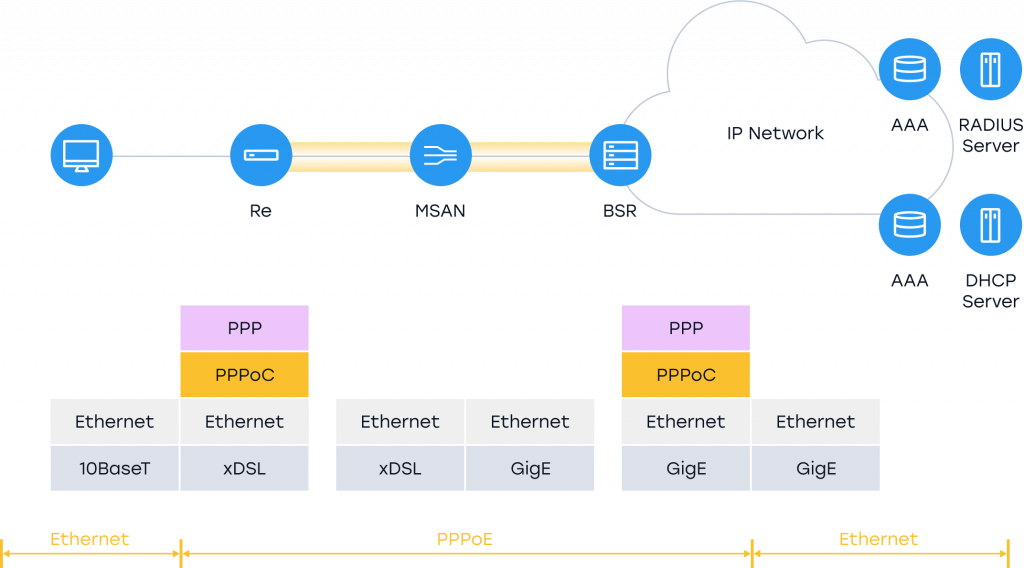
What PPPoE is
PPPoE stands for Point-to-Point-Protocol over Ethernet. It is a network protocol that is used to establish and manage connections between two Ethernet network nodes. PPPoE works on the OSI-model link layer, requires the user name and password to authenticate and establish a connection with the provider.
PPPoE has several features:
- it works over the Ethernet protocol;
- user name and password are used to establish the connection;
- PPPoE supports data encryption using PAP or CHAP.
With a PPPoE connection, the client’s computer or network device connects to the provider’s network via a DSL modem. The connection is encapsulated using PPP, which is then encapsulated in Ethernet frames for transmission over the LAN.
The original purpose of PPPoE is a simpler connection between devices using ISO 3309 framing. Since then, other methods have been developed, including PPP over ATM (PPPoA), PPP over SONET/SDH (POS), and PPP.
What PPPoE is used for
The protocol is used by providers to provide Internet access to their clients via DSL. In these types of connections, the DSL modem establishes a PPPoE connection to the provider’s network, which allows the client’s computer to access the Internet.
PPPoE is commonly used in situations where a broadband connection needs to be shared between multiple devices or users. For example, in a home network, a router can use PPPoE to establish a connection with the provider, and then transmit this connection to all devices connected to the network.
How PPPoE works
The first step of the process is the creation of a PPPoE connection in accordance with RFC 2516.
The second step is the creation of a connection over the Link Control Protocol (LCP) for matching parameters, for example, authentication.
The third step is subscriber authentication using the Challenge Handshake Authentication Protocol (CHAP). Other authentication protocols that can be used include Extensible Authentication Protocol (EAP).
Finally, IP addresses are assigned using the Internet Protocol Control Protocol (IPCP). After these steps, the network becomes available to the subscriber.

There is another important aspect of this process — PPPoE session monitoring. This feature uses PPP keepalives to monitor sessions from both endpoints.
PPPoE authorization takes place on the Ethernet page, where in the provider authentication section, in the authorization type field, you should specify PPPoE, then enter the user name and password provided by the provider to connect to the Internet.
PPPoE advantages
The advantages of PPPoE include the following:
- L2 two-level encapsulation
- unicast connections
- unique session identifiers
- support for various network protocols, including IPv4, IPv6 and IPX
- access control policy setting.
Differences between PPPoE and PPTP
PPTP (Point-to-Point Tunneling Protocol) is a protocol for creating a secure virtual network over the Internet. It allows remote users to securely connect to a private network via a public one. PPTP is used to create secure connections between remote users and a private network. PPPoE is used for internet access for individual clients.
The difference is also in security. It is believed that PPTP is less secure than other VPN protocols, for example, OpenVPN or IPsec, because it has vulnerabilities. PPPoE is considered secure for users who need internet access, because it is protected by authentication and encryption.
Difference between L2TP and PPPoE
L2TP is also used to create a VPN. L2TP is a combination of two other protocols: PPTP and L2F (Layer 2 Forwarding Protocol). Just like PPTP, L2TP uses a tunneling protocol to encapsulate PPP packets into IP packets for transmission over the Internet.
L2TP can be used with various types of networks, while PPPoE is intended only for Ethernet networks. L2TP also provides more robust security features than PPPoE, including the ability to encrypt data transmitted over a VPN.
Comparison of PPPoE, PPTP and L2TP
PPPoE, PPTP and L2TP are network protocols used for different purposes. Each protocol has its own strengths and weaknesses in terms of security, compatibility and scope of application.
It is worth adding that compared to PPTP and L2TP, PPPoE is considered more efficient and secure because it encrypts data packets transmitted over the network. In addition, it is easier to configure it on the router, for this you need to enter a user name and password.
Differences between PPPoE and DHCP in router configuration
PPPoE and DHCP are protocols that are commonly used in router configurations to provide internet access. Their main differences are in the router configuration.
Authentication:
- PPPoE requires provider authentication to establish a connection
- DHCP does not require authentication
Configuration:
- to establish a connection, PPPoE requires the user to enter the name and password provided by the provider
- DHCP assigns IP addresses to devices automatically, without requiring user input
Usage examples:
- PPPoE is used by providers to provide Internet access to individual clients over Ethernet
- DHCP is used by providers to automatically assign IP addresses to devices on the network
Limitations:
- PPPoE is limited to Ethernet networks and may have performance issues on large networks
- DHCP is a centralized system. If the DHCP server fails, clients will not be able to get IP addresses
Security:
- PPPoE provides secure authentication and encryption for individual client connections
- DHCP does not provide authentication and encryption
Conclusion
PPPoE is a reliable and efficient protocol for establishing an Internet connection over Ethernet, which is widely used by providers and home users. With a simple setting process and robust security features, PPPoE is a popular choice for internet access.